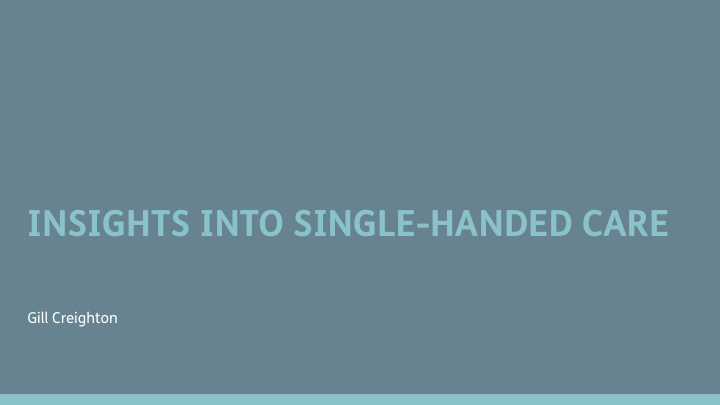



INSIGHTS INTO SINGLE-HANDED CARE Gill Creighton
What’s in a name? Single-handed Reduced Enhanced Future-proofing Improved Right-sizing
Why do we need single-handed care? People living longer Increasing complexity of care needs Lack of funding within Health and Social Care
Equipment
Successful Projects Thurrock Somerset Suffolk £119,000 in first year £280,000 £554,546 in first 18 months Ongoing saving of Projected to save £2.9 £9,000 per week million over 8 years Ongoing saving of £7,000 per week
Ingredients for success Good planning Multi-disciplinary approach Robust risk assessment
The Service User Assessment to establish strengths and needs Communication Consent Intervention Remain supported at home Increased independence Reduced care needs
Reablement Services Provides personal care, help with daily living activities and other practical tasks, usually for up to six weeks, reablement encourages service users to develop the confidence and skills to carry out these activities themselves and continue to live at home. Generally provided to people who have just been discharged from hospital or are otherwise entering the care system following a crisis. A 2007 study for the Department of Health’s care services efficiency delivery network found that up to 68% of people no longer needed a home care package after a period of reablement, and up to 48% continued not to need home care two years later.
National Minimum standards regulation for domiciliary care (2003 p.240) 12.8 ‘Two people fully trained in current safe handling techniques and the equipment to be used are always involved in the provision of the care…………… when the need is identified’
Fettering of discretion Whilst authorities have to act consistently by following their own policies, they must, paradoxically, also ensure they do not behave too consistently. An authority should not take over-rigid decisions; if it does so it might be fettering it’s discretion; this is unlawful because an authority cannot ‘slavishly follow a policy without regard to individual cases’. The concept of fettering discretion is used to prevent authorities from adopting blanket policies which they are not prepared to modify, even in exceptional circumstances. (M.Mandelstram 1997)
Loss aversion and risk aversion ‘a person would prefer to avoid a loss than to acquire an equivalent gain’ How would you feel if I gave you £10 now, and at the end of the day, take £5 away from you? Would you feel that you had lost or gained? Loss aversion leads to risk aversion - the avoidance of uncertainty or loss.
John Lived with wife Mary in a two bedroom bungalow Both in their 70’s Morbidly obese, diabetes, peripheral neuropathy, depressed Hadn’t left bedroom in 4 years Mary carried out all care Has ceiling track hoist, in-situ sling, standard community profiling bed, slide sheets, bariatric recliner chair Developed severe diarrhoea and skin breakdown Mary not coping Fully hoisted but due to skin condition use of slings unsuitable Cared for in bed Assessed as needing a care package of 4 carers 3 times a day
Problems Difficult to move on the bed Hates being handled by carers Risk of injury to carers Constant stream of people through the house – Piccadilly Circus syndrome Very expensive care package
Solutions Provision of bariatric profiling bed Assessment and subsequent provision of Vendlet V5 and Lejrelet cushions
Outcomes Reduction of care package to one carer twice a day to assist Mary with personal care Mary could manage the rest of his care on her own, including hoisting him out of bed to change sheets Improvement in John’s mental and physical health Substantial savings Stable care package Happy carers A saving of £104,534.68 over a three year period
The Business Case
Get it right first time Make sure any equipment request has strong justification with very clear evidence. Doing it again is time consuming, frustrating and costly.
Likert Scale Pain rating on a scale of 1-10
Body map Indicates areas on the SUs or carers body that are at risk or experiencing problems, pain or injury
Borg Scale A rating of perceived exertion and can be used with both SU and carer
REBA – Rapid Entire Body Assessment Provide a postural analysis system sensitive to musculoskeletal risks in a variety of occupational tasks Divide the body into segments which are coded individually with reference to movement planes Provide a scoring system for muscle activity caused by static, dynamic, rapid changing or unstable postures Reflect that grip and hand holds are important in the handling of loads Gives an action level with an indication of urgency
REBA – Rapid Entire Body Assessment Uses a systematic process to evaluate posture and risk during tasks
Points to remember Resistance to change Communication Training Planning Understanding of legislation
Questions?
References CDC (2015)Perceived Exertion (Borg Rating of Perceived Exertion Scale) Available from: https://www.cdc.gov/physicalactivity/basics/measuring/exertion.html HSE (2016) Work-related Musculoskeletal Disorder (WRMSDs) Statistics, Great Britain Available from: www.hse.gov.uk/statistics/index Middlesworth M (1989) A Step-by-Step Guide Rapid Entire Body Assessment (REBA) Available from: http://ergo-plus.com/wp-content/uploads/REBA-A-Step-by-Step-Guide.pdf Mickel A. (2010) ‘A ticking time bomb.’ Occupational Therapy News.18 (5) pp. 38-39. Samuel M (2010) What is Reablement Available from: http://www.communitycare.co.uk/2010/09/20/what-is-reablement/
Recommend
More recommend